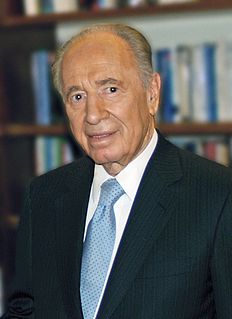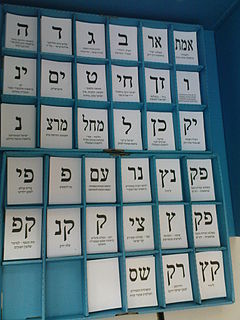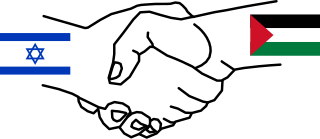Tehiya, originally known as Banai, then Tehiya-Bnai, was an ultranationalist political party in Israel. The party existed from 1979 until 1992. In the eyes of many, Tehiya was identified with Geula Cohen, who founded the party and headed it throughout its existence.

Agudat Yisrael is an ultra-Orthodox Jewish political party in Israel. It began as a political party representing ultra-Orthodox Jews in Poland, originating in the Agudath Israel movement in Upper Silesia. It later became the Party of many Haredim in Israel. It was the umbrella party for many, though not all, Haredi Jews in Israel until the 1980s, as it had been during the British Mandate of Palestine.
Elections for the 16th Knesset were held in Israel on 28 January 2003. The result was a resounding victory for Ariel Sharon's Likud.
The Elections for the eighth Knesset were held on 31 December 1973. Voter turnout was 78.6%. The election was postponed for two months because of the Yom Kippur War.
Legislative elections were held in Israel on 17 May 1977 to elect the ninth Knesset. For the first time in Israeli political history, the right-wing, led by Likud, won a plurality of seats, ending almost 30 years of rule by the left-wing Alignment and its predecessor, Mapai. The dramatic shift in Israeli politics caused by the outcome led to it becoming known as "the revolution", a phrase coined by TV anchor Haim Yavin when he announced the election results live on television with the words "Ladies and gentlemen—a revolution!". The election saw the beginning of a period lasting almost two decades where the left- and right-wing blocs held roughly equal numbers of seats in the Knesset.

The Alignment is the name of two political alliances in Israel. Each of these Alignment parties later merged into what is now the Israeli Labor Party.
Knesset elections were held in Israel on 30 June 1981. The ruling Likud won one more seat than the opposition Alignment, a surprise result as opinion polls and political momentum initially suggested that the Alignment would win roughly half of the votes while the Likud would only get twenty percent. Voter turnout was 78.5%, with Likud receiving around ten thousand more than the Alignment. This elections highlighted the polarization in the country.
Elections for the eleventh Knesset were held in Israel on 23 July 1984. Voter turnout was 78.8%. The results saw the Alignment return to being the largest party in the Knesset, a status it had lost in 1977. However, the party could not form a government with any of the smaller parties, resulting in a national unity government with Likud, with both party leaders, Shimon Peres and Yitzhak Shamir, holding the post of Prime Minister for two years each.
Elections for the 13th Knesset were held in Israel on 23 June 1992. The election resulted in the formation of a Labor government, led by Yitzhak Rabin, helped by the failure of several small right wing parties to pass the electoral threshold. Voter turnout was 77.4%.
The dirty trick refers to a political scandal that erupted in Israel in 1990. It referred to an attempt by Shimon Peres to form a minority government made up of the left-wing factions and the ultra-orthodox parties. It failed when the ultra-orthodox parties backed out on the deal.

The Leader of the Opposition is the politician who leads the Official Opposition in the Israeli legislative body, the Knesset.

The Nineteenth government of Israel was formed by Menachem Begin on 5 August 1981, following the June elections. Begin included Likud, the National Religious Party, Agudat Yisrael, Tami and Telem in his coalition, which held 63 of the 120 seats in the Knesset, and the cabinet had 17 ministers. On 26 August Tehiya joined the coalition, and the number of ministers rose to 18.

The twenty-first government of Israel was formed by Shimon Peres of the Alignment on 13 September 1984, following the July elections. With both the Alignment and Likud winning over 40 seats each, neither side could form a stand-alone coalition, resulting in a national unity government, together with the National Religious Party, Agudat Yisrael, Shas, Morasha, Shinui and Ometz, which together held 97 of the 120 seats in the Knesset. However, in protest at the alliance with Likud, Mapam broke away from the Alignment, as did Yossi Sarid, who joined Ratz.

The twenty-second government of Israel was formed by Yitzhak Shamir of Likud on 20 October 1986. Shamir replaced Shimon Peres of the Alignment as Prime Minister as part of a rotation deal within the national unity coalition between the two parties. The only other change to the coalition was that the one-seat Morasha faction was not included, with the National Religious Party, Agudat Yisrael, Shas, Shinui and Ometz remaining part of the government, although Shinui left on 26 May 1987.

The twenty-third government of Israel was formed by Yitzhak Shamir of Likud on 22 December 1988, following the November 1988 elections. The government remained a national unity coalition between Likud and the Alignment, with the National Religious Party, Shas, Agudat Yisrael and Degel HaTorah also being members of the coalition. It was the first government to have a Minister of the Environment.

The twenty-fourth government of Israel was formed by Yitzhak Shamir of Likud on 11 June 1990. This followed the failure of Alignment leader Shimon Peres to form a government, after the Alignment had pulled out of the previous national unity coalition, in an incident which became known as the dirty trick.

The twenty-seventh government of Israel was formed by Benjamin Netanyahu of Likud on 18 June 1996. Although his Likud-Gesher-Tzomet alliance won fewer seats that the Labor Party, Netanyahu formed the government after winning the country's first ever direct election for Prime Minister, narrowly defeating incumbent Shimon Peres. This government was the first formed by an Israeli national born in the state after independence in 1948.













